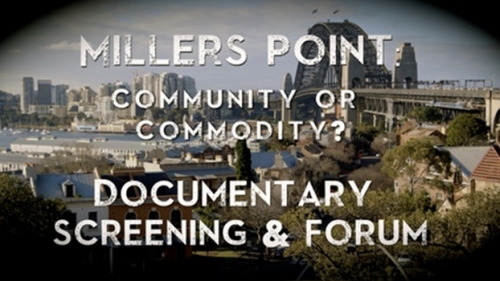The public screening of the documentary ‘Millers Point – Community or Commodity’ on 19 March at the State Parliament House theatrette served to illustrate the inherent injustice in the current policies impacting upon public housing tenants. The film maker Blue Lucerne sees it as a work in progress, as further developments in this socially divisive practice will no doubt continue to hurt an otherwise vibrant and tightly-knit community, and will deserve recording to advise the wider community about this travesty.

A preferable outcome would see the sell-off stopped and the community reassured that their tenure, in an area where many families have lived for generations, secured. The panel discussion following the screening, moderated by journalist Quentin Dempster, who acknowledged that he was a resident of the area himself, supported this alternative and identified the negative consequences of this process for both the community and the wider social housing agenda. Panel speakers including Michael Darcy, Director of the Urban Research Centre, at the University of Western Sydney, Eva Cox – social commentator and activist, Patrick Fensham – Principal and Partner with SGS Economics and Planning, Kim Boettcher – Delegate, Aged Care Rights Service, Shirley Fitzgerald – historian, and Paul McAleer, Secretary of the Maritime Union of Australia’s Sydney branch. They all emphasised the way in which the economic prerogative was over-riding the social concern and the rights of affected individuals to community support.
Several spokespersons noted that this NSW housing agenda, to create a cost-neutral public housing sector which would not impact upon the state’s budgetary bottom line, was evidence of a growing trend of governments to ‘manage our assets’ at the expense of ‘caring for our communities’. It was suggested that this thin end of the wedge, if successful, would in all likelihood lead to the further sell-off of public housing in other inner Sydney suburbs such as Glebe and Pyrmont.
The consequence of this would be the relocation of public housing residents to areas on the fringes of the city, devoid of adequate employment, transport and social support services, thus further limiting the opportunity for these self-same people to enjoy equitable living conditions. This is in direct opposition to the chief objective of a new housing system designed to be ‘A social housing system that is a safety net for vulnerable people: provides opportunity and pathways to client independence and is fair and sustainable’. 1Marginalisation of the most needy in the community, together with a reduction in the number and relative proportion of public housing units is certainly not the sign of a caring society.
1. Social Housing in NSW: A discussion paper for input and comment. NSW Government, Family and Community Services November 2014.p.7










One comment. Please add yours.
Dear John,
It was nice of you to feature a photograph of my home on the front page of the Bulletin. The photo and caption first appeared last October in the SMH. On that occasion I wrote to the Herald to suggest that the most basic fact checking would reveal there are no department of housing homes in Queen Street. Fortunately I did not then have the experience of people asking what is a well off barrister like you doing in a department of housing property, but there are a number of Glebe residents who read the Bulletin who may well think that I’m taking the place of an otherwise homeless person. I’m not too impressed by Clover jumping up and down about Millers Point, a situation she has little control over, in circumstances where she voted for the demolition of Cowper Street, and its replacement with high rise.
Hands Off Glebe have organised a meeting between Glebe residents and Millers Point residents on 7 May 2014 from 7pm at the Old Fire Station. You and everyone from the Glebe Society are very welcome to attend.